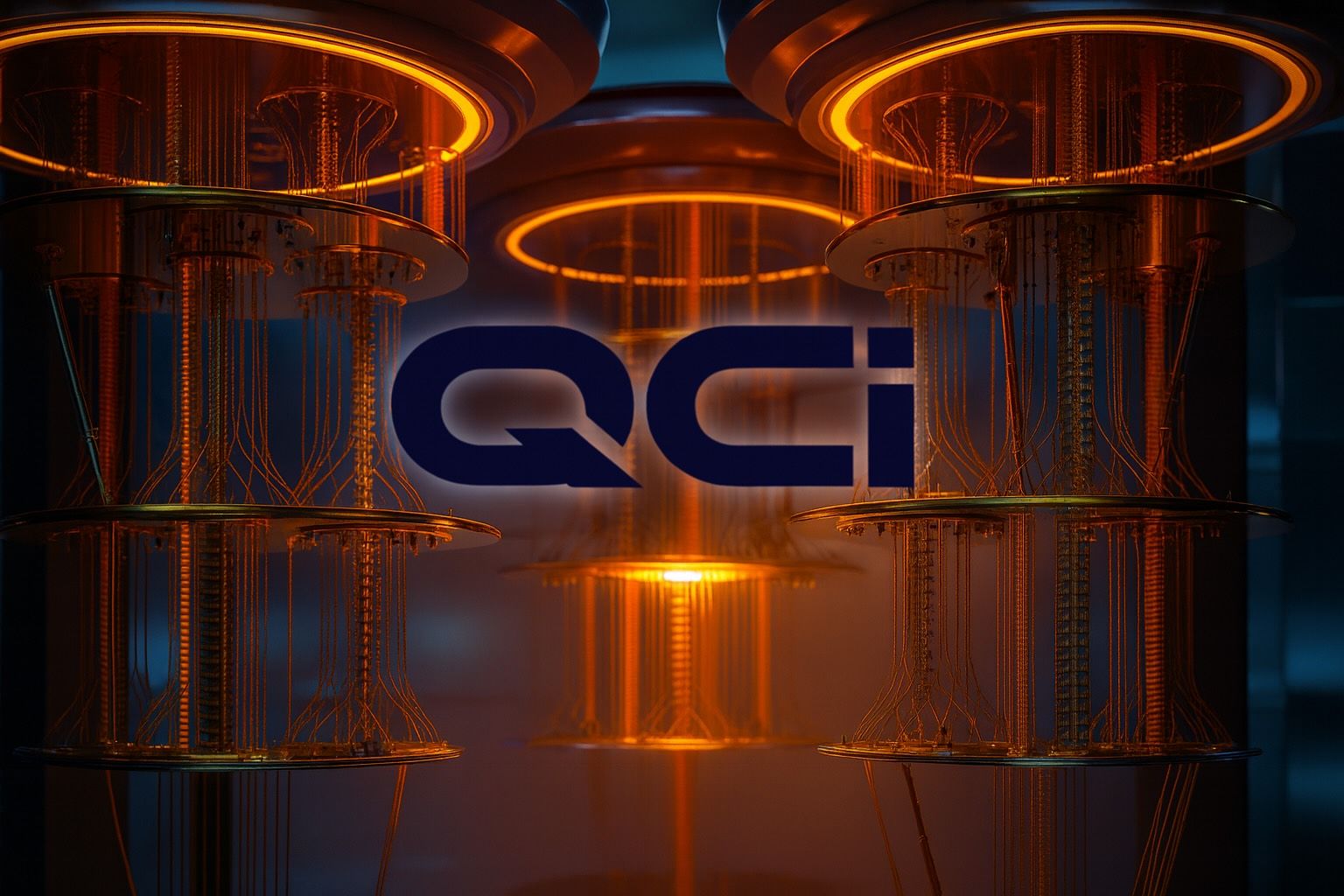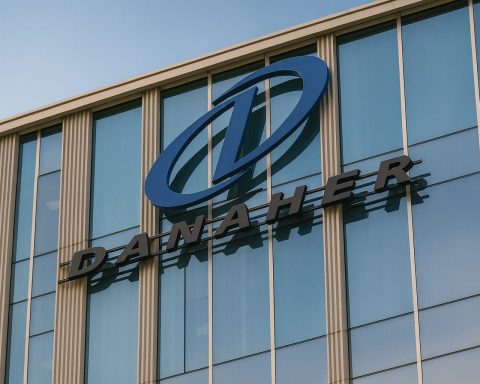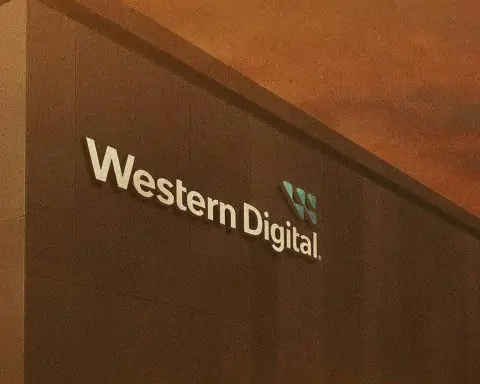- Astronomical run-up: QUBT’s share price has exploded from ~$0.65 a year ago to roughly $16–17 by Oct 31, 2025 [1] [2]. The stock has gained over 2,500–3,200% year-to-date on extreme volatility. On Oct. 31 it jumped ~11.6% intraday (as high as $16.79) after closing at $14.97 [3].
- Massive capital raise: On Oct. 5, 2025 QUBT closed an oversubscribed $750 million at-market stock offering (37.18M new shares) [4] [5]. This brings total funding since late 2024 to about $1.6 billion. CEO Yuping Huang boasts this gives QUBT “the strongest balance sheet among publicly traded quantum companies” and “runway through 2028” [6]. Pro forma cash on hand is roughly $1.5–1.6 billion [7] [8].
- Technology spotlight: QCi (Quantum Computing Inc) focuses on room-temperature photonic quantum hardware. In late Sept. 2025 it debuted a “Quantum Secure Solution” – a time-energy entangled quantum encryption network for telecom (at ECOC 2025) [9]. Its product lineup includes the Dirac-3 photonic quantum computer, the Emu quantum-AI accelerator, a quantum random-number (“Entropy”) unit, and photonic chip foundry services [10] [11].
- Gov’t contracts & partnerships: QUBT has won several government and industry deals: e.g. a NASA Langley subcontract (Apr 2025) for LIDAR data denoising using its Dirac-3 machine [12], and an Aug 2025 NIST contract to design/fabricate thin-film lithium niobate photonic chips [13] [14]. It also landed a small chip order from a Fortune-500 defense contractor [15] [16]. C-suite commentary highlights these as milestones for long-term partnerships [17] [18].
- Financials: QCi is still pre-revenue. For Q2 2025 (quarter ended June) it reported only $61K in sales against a $36M loss (mainly non-cash warrant charges) [19] [20]. Annual 2024 revenue was just $373K [21]. The company burns cash on R&D and building its foundry; its losses outpace any negligible sales [22] [23].
- Analyst views: Wall Street opinions are polarized. Some firms (Ascendiant Capital, Lake Street, Barron’s) are bullish – Ascendiant raised its 12‑mo target to $40 [24] [25], Lake Street initiated a $24 target. Others (Weiss Ratings, Wall StreetZen, Zacks) warn of a “hype bubble” – Zacks gave a Sell rank due to “widening losses” and tiny revenues [26]. Consensus targets range roughly $15–$40 [27] (MarketBeat average ~$26.33) [28] [29]. As one analyst cautioned, “only time will tell whether QCi lives up to expectations… in the near term, hope and hype could continue” to drive the stock [30].
Recent News & Events
Over the past week, major headlines have centered on QUBT’s financing and sector catalysts. On Oct. 31, 2025 QCi announced it will host its 3Q 2025 shareholder conference call on Nov. 14 [31]. Earlier in October (Oct. 5) it closed the oversubscribed $750M stock offering [32], a key development that swelled its cash to ~$1.5B. That funding round (led by Titan Partners) was announced in early Oct [33] after a $500M private placement in late Sept (upsized to $750M by Oct) [34]. CEO Huang remarked that this capital infusion “validates our vision, technology, and roadmap” and gives “the strongest balance sheet among publicly traded quantum companies” [35].
Earlier in Oct, QUBT moved with broader quantum sector news. On Oct. 23 a Wall Street Journal/Reuters report speculated the U.S. government might take stakes in leading quantum firms; QUBT shares jumped ~8–16% on Oct. 23–24 amid that excitement [36] [37] (the Commerce Dept. later denied current negotiations [38]). Around Oct. 14, JPMorgan announced a new 10‑year, $10 billion investment initiative for U.S. “security and resiliency” sectors – explicitly including “frontier technologies such as … quantum computing” [39]. News of JPMorgan CEO Dimon’s speech helped lift all quantum stocks, including QUBT. Conversely, stock swing was also driven by company news: QUBT’s stock dropped ~11% on Oct. 2 when details of the $750M offering and new products leaked, but it rebounded Oct. 3–4 as market enthusiasm returned [40] [41].
At the tech level, QCi has kept up its product momentum. On Sept. 29, 2025 it showcased a new “Quantum Secure Solution” at the ECOC conference [42]. This is a high-dimensional quantum encryption network (time-energy entangled photons) that runs at room temperature and integrates with fiber telecoms, aimed at securing data for telecom and defense networks. CEO Yuping Huang stressed the platform “is not theoretical – it’s built for deployment in real-world infrastructure today” [43]. CRO Pouya Dianat added that the ECOC demo “marks a milestone in our plans to make our patented quantum-secure technology mainstream” [44].
In government collaborations, QCi’s August 2025 NIST contract (Thin-Film Lithium Niobate photonic chips) and an April 2025 NASA LIDAR contract are notable. The NIST award, QCi’s first direct government foundry contract, involves designing/fabricating advanced photonic chips [45] [46]. Evertiq reported COO Milan Begliarbekov saying the NIST deal “reinforces the broad applicability of our TFLN platform across high-security, mission-critical environments” [47]. NASA’s Langley Research Center awarded QCi a ~$406K subcontract to use its Dirac-3 quantum processor for removing sunlight noise from space-based LIDAR data [48], a project QCi believes could transform atmospheric sensing from satellites. These contracts, while small in revenue, underscore government confidence in QCi’s tech [49] [50].
Finally, a securities lawsuit was filed in Sept. 2025 against QCi (typical for small caps) alleging the company inflated claims during its share surge [51]. Management maintains its disclosures are accurate, but this adds a layer of uncertainty.
Market Performance & Technical Outlook
QUBT’s stock chart shows the wild ride of 2025: a near-parabolic rally into late summer, followed by sharp swings on news. After languishing near $1 last year, QUBT’s market cap ballooned into the multi-billion range this year [52]. The stock hit an intraday high around $27 (52-week high $27.15 [53]) in late Sept, then pulled back into the low-$20s. On Oct. 31 it traded up to $16.79 intra-day (closing $16.71) after spiking ~11.6% mid-day [54]. QUBT’s beta is ~3.8 [55] and short interest is very high (~20% of float [56]), so big daily moves are common.
From a technical standpoint, analysts note QUBT was in a textbook “blow-off” top and is now finding support. Its 50-day moving average sits near ~$17 (50-dma ~$17.86 [57]), and the 200-day average is around $15.3 [58]. FXLeaders reports that after breaking below its 20-day MA, QUBT “found temporary support above the 200-day moving average” [59]. The 50-day SMA near $15 now acts as a key line of defense [60]. As one chart analyst put it, observers will watch if QUBT can hold ~$15–18; “a break below ~$15 could signal further technical downside” [61]. In summary, the chart is extended but not yet at clear bottom – any sustained slide under its 200-day MA (~$15) would be a bearish signal, while reclaims above ~$18 might hint at another leg up.
| Metric | Value (Oct 31, 2025) |
|---|---|
| Price (Nasdaq close) | $16.71 [62] |
| Day Change (Oct 31) | +11.6% (to $16.79 intraday) [63] |
| 52‑Week Range | $1.03 – $27.15 [64] |
| Market Cap | ~$3.74 billion [65] |
| Shares Outstanding | ~224.1 million [66] |
| Price/Book (latest) | ~10× [67] |
| P/E (trailing) | n/a (loss; EPS –0.64 [68]) |
| 50‑Day / 200‑Day SMA | $17.86 / $15.31 [69] |
| Beta (5Y) | ~3.8 [70] |
| Analyst Consensus (avg.) | Strong Buy, 12-mo PT ≈$26.33 [71] [72] |
| Next Earnings Date | Nov 14, 2025 (post-close) [73] |
The recent performance table above highlights the key data. Notably, QUBT’s 50/200-day averages are currently above/below its trading price, reflecting the recent selloff. Volume is elevated (Oct. 31 trading ~44.7M shares [74]), about 1.6× its 3-month average. In sum, the stock’s extreme P/B (~10×) and chart patterns mean investors see high risk. As one analyst warns, such “hype” rallies often reverse if earnings disappoint [75] [76].
Financial Performance & Outlook
Quantum Computing Inc is still firmly in investment mode. Fiscal 2024 revenue was a mere $373K [77], rising only slightly from 2023 ($358K). It posted a net loss of $68.5M in 2024 [78]. In Q2 2025 (ended June), QUBT reported virtually no meaningful sales ($61,000) against a $36.4M operating loss [79] [80]. (A large non-cash warrant write-down inflated that loss; excluding it the core loss was ~$8.5M [81].) These meager revenues were driven by small R&D contracts and one-off orders – e.g. a ~$332K quantum-security system order from a top-5 bank [82]. On a per-share basis, Q2 EPS was –$0.06, in line with estimates [83].
Looking ahead, the market’s focus is on cash burn versus future traction. With ~$1.5B in cash (post-offering) and virtually no debt [84] [85], QCi can continue funding R&D for years. Management has guided that it will not achieve significant sales in the near term; the strategy is to “win the race for photonic quantum advantage, then profits will follow” [86]. There is no confirmed revenue guidance yet – the next real test is Q3 results (to be announced after the Nov. 14 call). Analysts estimate only modest revenue growth in 2025–26: for example, Ascendiant’s bullish note assumes “strong revenue growth in 2025 and 2026” driven by new products [87]. Zacks, by contrast, warns that “widening losses” and “shrinking revenues” warrant caution [88]. In sum, until QUBT can demonstrate recurring sales from its chips or systems, it will remain a high-burn speculative play.
Technology and Product Updates
QCi’s technology focus is on integrated photonic quantum systems – leveraging thin-film lithium niobate (TFLN) chips that operate at room temperature. Its Dirac-series quantum computers (e.g. Dirac-3) use photonic qubits for high-speed optimization and sensing. In April 2025, QCi announced (via NASA PR) that it would apply its Dirac-3 machine to remove solar interference in spaceborne LIDAR data [89]. This shows the company is pursuing concrete applications of its quantum hardware. QCi also makes quantum security hardware: in Sept 2025 it introduced a high-dimensional QKD (quantum key distribution) system that uses time-energy entangled photons to secure optical fiber links [90]. CEO Huang emphasized that unlike academic prototypes, this solution is “built for deployment in real-world infrastructure today” [91].
In August 2025, QCi opened a photonic chip foundry in Tempe, AZ, to manufacture its TFLN circuits. The NIST contract awarded in Aug ’25 will utilize this foundry to produce mission-critical components (low-loss waveguides, high-speed modulators) [92]. Beyond hardware, QCi has a product called the “Entropy” quantum random number generator (for cryptography) and the “Emu” quantum-AI accelerator (for machine-learning tasks) that it began piloting with commercial partners. For example, it delivered an Emu unit to a major automaker for an R&D trial [93]. In summary, QUBT’s tech roadmap spans computing (Dirac quantum PCs), security (QKD networks, QRNGs), and sensing – all built around its photonic platform [94] [95]. These innovations, while promising, are still largely in prototype or early test phases; commercial-scale revenues from them have yet to materialize.
Partnerships, Contracts & Government Ties
QUBT’s recent news highlights the importance of strategic partnerships. In addition to NASA and NIST, QCi has engaged with defense and research institutions. As noted, a Fortune-500 defense technology contractor is now a customer (ordering TFLN chips) [96]. CTO Begliarbekov said signing a “leading defense contractor” shows the broad applicability of QCi’s platform [97]. QCi also cites deals with a “top-5 U.S. bank” (for quantum cybersecurity) and collaborations with universities in Germany (TU Delft) and South Korea, indicating interest from both commercial and academic users [98] [99].
Importantly, QCi appears to be squarely on the radar of U.S. policymakers. The company has repeatedly emphasized that its mission aligns with national priorities (cybersecurity, supply chain resilience, tech sovereignty). Reports this year that the U.S. government is exploring equity stakes or funding programs for quantum tech (see Reuters, Oct 2025) have given QUBT a publicity boost [100] [101]. Even though those reports were later moderated, analysts note the Biden (Trump-era) administration sees quantum as strategically critical. QCi’s PR speaks of securing “domestic access to cutting-edge photonic technologies” [102] and “long-term government partnerships” [103]. In short, QUBT is positioning itself as a flagship U.S. quantum company, which could yield priority for grants or contracts going forward – though nothing is guaranteed.
Competitive Landscape
Quantum Computing Inc is part of a very small club of pure-play quantum hardware stocks. The “Big Four” in public quantum computing are IonQ (IONQ), Rigetti (RGTI), D-Wave (QBTS) and QCi (QUBT). All have seen enormous rallies in 2025: for example, in early Oct one analyst noted IonQ was up ~270% YTD, Rigetti and D-Wave ~3,200–3,270%, and QCi ~1,300% [104]. (QCi’s total gain is smaller because it started from an even lower base and has been more volatile.) Each competitor uses a different qubit technology (trapped ions for IonQ, superconducting for Rigetti, annealing for D-Wave, and photonic for QCi).
While peer advances (like Rigetti winning multi-million-dollar orders or D-Wave securing pilot projects) have helped justify bullish sentiment in QCi [105], QCi does have a niche. Its photonic approach is unique: its chips run at room temperature (unlike IonQ’s cooled traps or Rigetti’s cryogenics) [106]. This could be an advantage in scaling and integration, but also unproven at commercial scale. Large tech players (IBM, Google, Intel, Microsoft) are also racing in quantum, but they generally focus on superconducting or ion qubits and have far deeper pockets. So QCi’s competition is mostly the other three public names plus a handful of VC-backed startups in photonics (e.g., Xanadu in Canada).
In this landscape, valuation comparisons are extreme. All the pure-play stocks trade at eye-popping multiples: for QCi, the price-to-book is ~10× [107] and price-to-sales is many thousands× (since sales are near zero) [108] [109]. By contrast, established tech firms invest in quantum from a loss (e.g. IBM, Google say practical quantum years away [110]). Some market commentators warn that if one of these hopefuls fails to deliver, the sector could see a harsh correction (a “quantum winter”). For now, however, QUBT stands out as the sector’s hottest stock – exactly the kind of fast-blooming opportunity (and risk) that “fear of missing out” can create [111] [112].
Analyst Commentary & Forecasts
Wall Street’s limited coverage of QUBT is mostly positive, but not unanimous. Ascendiant Capital Markets analyst Edward Woo reiterated a Buy rating with a $40 price target on Oct. 3, 2025, citing expected “strong revenue growth in 2025 and 2026” from QCi’s new products [113]. Lake Street Capital (which initiated coverage in mid-Sept) has a Buy and $24 target, arguing QCi’s first-mover photonic advantage will drive future sales [114]. In fact, the only explicit consensus data (MarketBeat/StockAnalysis) shows 2 Buys, 1 Hold, 1 Sell, averaging a “Hold” rating and a 12‑mo target around $26.33 [115] [116].
On the bearish side, quantitative firms have been negative: Weiss Ratings maintained a Sell (e+) on Oct. 8 [117], and Wall Street Zen downgraded QUBT to Strong Sell in Aug. 2025, reflecting concerns over valuation and execution. Zacks Investment Research recently gave QUBT a Rank #4 (Sell), explicitly warning of QUBT’s “widening losses” and negligible revenue [118]. Simply Wall Street and other analysis sites note the company is essentially “pre-commercial” – they caution that without meaningful sales, any analyst target is speculative.
Mixing these views, investors see a wide range of outcomes. As one MarketBeat summary puts it, price targets span roughly $15–$40 [119]. Barron’s (citing unnamed analysts) even suggested shares “could rise 86%” more from late Oct 2025 levels [120], though that is clearly a bull-case extreme. Many observers use colorful language: some cheer a potential “quantum gold rush,” while others warn of a classic tech bubble. As Motley Fool commented, “Only time will tell whether QCi lives up to expectations… yet in the near term, hope and hype could continue” to move the stock [121].
Summary: Quantum Computing Inc (QUBT) is a high-profile, high-risk quantum hardware play. Its stock’s recent performance has been breathtaking, fueled by massive financing, technological milestones, and sector momentum. The company boasts impressive product demos and government contracts, but still has almost no recurring revenue. Analysts’ opinions vary wildly – from strong Buy to cautious Hold/Sell – reflecting the uncertainty. Going forward, QCi’s share price will hinge on whether its technology delivers real commercial results. For now, QUBT remains a bet on future promise: the verdict on whether it’s a breakthrough investment or a speculative bubble will only become clear with time [122] [123].
Sources: Recent developments and quotes are drawn from Quantum Computing Inc. press releases [124] [125] [126] [127], market analyses (e.g. ts2.tech [128] [129]), financial news outlets (Reuters [130] [131], MarketBeat [132] [133], StockAnalysis [134] [135], Insider Monkey [136], and FXLeaders [137] [138]). Additional context and data come from credible tech and finance sites including PRNewswire, Evertiq [139] [140], and company filings. All information is current as of Oct. 31, 2025.
References
1. ts2.tech, 2. www.marketbeat.com, 3. www.marketbeat.com, 4. quantumcomputinginc.com, 5. ts2.tech, 6. ts2.tech, 7. quantumcomputinginc.com, 8. ts2.tech, 9. quantumcomputinginc.com, 10. quantumcomputinginc.com, 11. ts2.tech, 12. quantumcomputinginc.com, 13. www.prnewswire.com, 14. evertiq.com, 15. www.prnewswire.com, 16. evertiq.com, 17. evertiq.com, 18. evertiq.com, 19. ts2.tech, 20. ts2.tech, 21. stockanalysis.com, 22. ts2.tech, 23. stockanalysis.com, 24. www.insidermonkey.com, 25. ts2.tech, 26. ts2.tech, 27. ts2.tech, 28. www.marketbeat.com, 29. stockanalysis.com, 30. ts2.tech, 31. stockanalysis.com, 32. quantumcomputinginc.com, 33. quantumcomputinginc.com, 34. ts2.tech, 35. ts2.tech, 36. www.reuters.com, 37. ts2.tech, 38. www.reuters.com, 39. www.reuters.com, 40. ts2.tech, 41. www.fxleaders.com, 42. quantumcomputinginc.com, 43. quantumcomputinginc.com, 44. quantumcomputinginc.com, 45. www.prnewswire.com, 46. evertiq.com, 47. evertiq.com, 48. quantumcomputinginc.com, 49. www.prnewswire.com, 50. quantumcomputinginc.com, 51. ts2.tech, 52. ts2.tech, 53. stockanalysis.com, 54. www.marketbeat.com, 55. stockanalysis.com, 56. ts2.tech, 57. www.marketbeat.com, 58. www.marketbeat.com, 59. www.fxleaders.com, 60. www.fxleaders.com, 61. ts2.tech, 62. stockanalysis.com, 63. www.marketbeat.com, 64. stockanalysis.com, 65. stockanalysis.com, 66. stockanalysis.com, 67. www.fxleaders.com, 68. stockanalysis.com, 69. www.marketbeat.com, 70. stockanalysis.com, 71. www.marketbeat.com, 72. stockanalysis.com, 73. stockanalysis.com, 74. stockanalysis.com, 75. www.fxleaders.com, 76. ts2.tech, 77. stockanalysis.com, 78. stockanalysis.com, 79. ts2.tech, 80. ts2.tech, 81. ts2.tech, 82. ts2.tech, 83. www.marketbeat.com, 84. ts2.tech, 85. quantumcomputinginc.com, 86. ts2.tech, 87. www.insidermonkey.com, 88. ts2.tech, 89. quantumcomputinginc.com, 90. quantumcomputinginc.com, 91. quantumcomputinginc.com, 92. www.prnewswire.com, 93. ts2.tech, 94. quantumcomputinginc.com, 95. www.prnewswire.com, 96. www.prnewswire.com, 97. evertiq.com, 98. ts2.tech, 99. ts2.tech, 100. www.reuters.com, 101. ts2.tech, 102. www.prnewswire.com, 103. evertiq.com, 104. www.nasdaq.com, 105. ts2.tech, 106. ts2.tech, 107. www.fxleaders.com, 108. www.fxleaders.com, 109. ts2.tech, 110. www.reuters.com, 111. www.nasdaq.com, 112. ts2.tech, 113. www.insidermonkey.com, 114. www.marketbeat.com, 115. www.marketbeat.com, 116. stockanalysis.com, 117. www.marketbeat.com, 118. ts2.tech, 119. ts2.tech, 120. ts2.tech, 121. ts2.tech, 122. ts2.tech, 123. www.fxleaders.com, 124. quantumcomputinginc.com, 125. quantumcomputinginc.com, 126. www.prnewswire.com, 127. quantumcomputinginc.com, 128. ts2.tech, 129. ts2.tech, 130. www.reuters.com, 131. www.reuters.com, 132. www.marketbeat.com, 133. www.marketbeat.com, 134. stockanalysis.com, 135. stockanalysis.com, 136. www.insidermonkey.com, 137. www.fxleaders.com, 138. www.fxleaders.com, 139. evertiq.com, 140. evertiq.com







